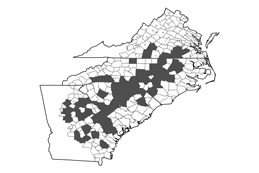![]()
<< Back :: Virginia :: North Carolina :: South Carolina :: Georgia :: FWGNA Home ::
![]()
<< Back :: Virginia :: North Carolina :: South Carolina :: Georgia :: FWGNA Home ::
> Goniobasis
catenaria
catenaria (Say 1822)
"Elimia" catenaria
> Habitat & distribution
Populations of the typical form of G.
catenaria
inhabit rivers and streams of the piedmont and upper
coastal plain from southern Virginia (Hoffman 1996) to Georgia.
Trans-Appalachian populations are found in western North
Carolina and north Georgia (Dillon & Robinson 2009). Goniobasis catenaria catenaria does not
occur in acidic or in nutrient-poor waters, and seems to require at
least some rock substrate. Thus it is not found in the slow
coastal plain rivers, nor in the (many) southeastern streams with
high sediment loads. Its present spotty distribution (especially
in South Carolina) may be a
remnant of a much broader distribution prior to agriculture (Dillon
& Keferl 2000). 
> Ecology & Life history
Although there have been no detailed studies of G. catenaria catenaria life
history, I imagine that two years are required for maturity, and that
several years of iteroparous reproduction can be expected thereafter,
as is the case for pleurocerids generally (Dazo 1965). This is
life cycle G of Dillon (2000:
156 - 162). The
Georgia Goniobasis populations studied
by Nelson & Scott (1962), Krieger & Burbanck (1976), and Krieger (1977)
are all referable to G. catenaria (see below) and all
seem restricted to scattered rocky shoals isolated by long stretches of
inhospitable silt. Where they reach high densities, however,
grazing by pleurocerid populations can have a significant effect on
energy flow in streams (Dillon 2000: 86 - 91).
> Taxonomy & Systematics
The type locality of G. catenaria ("St. Johns, Berkeley") must have been Eutaw Springs, sadly now drowned
by Lake Marion. The viable G.
catenaria catenaria population nearest Eutaw Springs today
inhabits Cedar Creek, a tributary of the Broad River about 12 km N of
Columbia. Dillon & Reed (2002) reported that the level of
genetic divergence between the Columbia population and eight other G. catenaria populations sampled
from North Carolina into Georgia was roughly comparable to the
better-studied G. proxima.
Mihalcik & Thompson (2002) proposed that the range of G. catenaria is attenuated at the South Carolina border, and that Georgia streams are inhabited by a great variety of other Goniobasis species, largely endemic, not distinguishable to our eyes from G. catenaria. Recent allozyme and mtDNA sequence data have demonstrated, however, that the range of G. catenariadoes
indeed extend across Georgia, to include all major Atlantic
drainages as well as the Chattahoochee/Flint and Alabama/Coosa of the
Gulf, extending even to the Hiwassee drainage of the Tennessee
River (Dillon & Robinson 2009, in review). See my FWGNA essay
of 16Mar09, from the link below.
Synonyms of G. catenaria include albanyensis, boykiniana, caelatura, christyi, darwini, interrupta, lecontiana, mutabilis, postelli, suturalis, and viennaensis (see also Chambers 1990).
Burch resurrected the name "Elimia" to
include catenaria and
approximately 80 other pleurocerid species traditionally assigned to Goniobasis (Lea 1862). But Elimia (H. & A. Adams 1854) is
a composite group, explicitly rejected by Tryon, Walker, Pilsbry and
Goodrich (Dillon 1989). See essay below.
> Supplementary Maps and Resources [PDF]
> Essay #1
See my 28Sept04 post to the FWGNA web site for a review of the Goniobasis/Elimia taxonomic
controversy.
>Essay #2
See my FWGNA post of 16Mar09, "The Snails The Dinosaurs Saw," for more on the genetics, taxonomy, and distribution of G. catenaria.
> Pretty Photo
of living G. catenaria catenaria,
courtesy of Chris Lukhaup.
Robert T. Dillon, Jr.
Department of Biology, College of
Charleston
Charleston, SC 29424
P: 843.953.8087
F: 843.953.5453